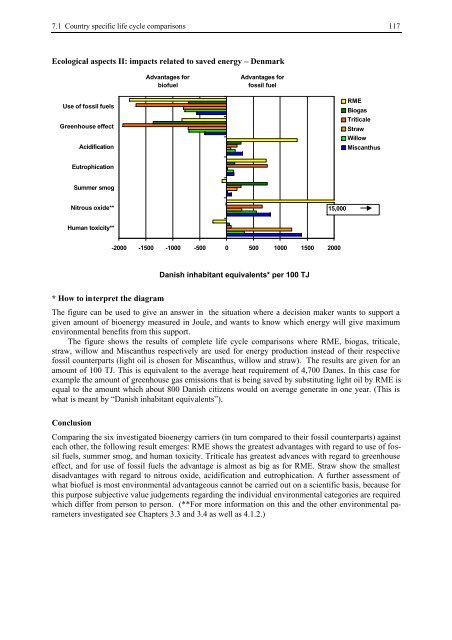BIOENERGY FOR EUROPE: WHICH ONES FIT BEST?
BIOENERGY FOR EUROPE: WHICH ONES FIT BEST?
BIOENERGY FOR EUROPE: WHICH ONES FIT BEST?
Create successful ePaper yourself
Turn your PDF publications into a flip-book with our unique Google optimized e-Paper software.
7.1 Country specific life cycle comparisons 117<br />
Ecological aspects II: impacts related to saved energy – Denmark<br />
Use of fossil fuels<br />
Greenhouse effect<br />
Acidification<br />
Eutrophication<br />
Summer smog<br />
Nitrous oxide**<br />
Human toxicity**<br />
* How to interpret the diagram<br />
Advantages for<br />
biofuel<br />
Advantages for<br />
fossil fuel<br />
-2000 -1500 -1000 -500 0 500 1000 1500 2000<br />
Danish inhabitant equivalents* per 100 TJ<br />
15,000<br />
RME<br />
Biogas<br />
Triticale<br />
Straw<br />
Willow<br />
Miscanthus<br />
The figure can be used to give an answer in the situation where a decision maker wants to support a<br />
given amount of bioenergy measured in Joule, and wants to know which energy will give maximum<br />
environmental benefits from this support.<br />
The figure shows the results of complete life cycle comparisons where RME, biogas, triticale,<br />
straw, willow and Miscanthus respectively are used for energy production instead of their respective<br />
fossil counterparts (light oil is chosen for Miscanthus, willow and straw). The results are given for an<br />
amount of 100 TJ. This is equivalent to the average heat requirement of 4,700 Danes. In this case for<br />
example the amount of greenhouse gas emissions that is being saved by substituting light oil by RME is<br />
equal to the amount which about 800 Danish citizens would on average generate in one year. (This is<br />
what is meant by “Danish inhabitant equivalents”).<br />
Conclusion<br />
Comparing the six investigated bioenergy carriers (in turn compared to their fossil counterparts) against<br />
each other, the following result emerges: RME shows the greatest advantages with regard to use of fossil<br />
fuels, summer smog, and human toxicity. Triticale has greatest advances with regard to greenhouse<br />
effect, and for use of fossil fuels the advantage is almost as big as for RME. Straw show the smallest<br />
disadvantages with regard to nitrous oxide, acidification and eutrophication. A further assessment of<br />
what biofuel is most environmental advantageous cannot be carried out on a scientific basis, because for<br />
this purpose subjective value judgements regarding the individual environmental categories are required<br />
which differ from person to person. (**For more information on this and the other environmental parameters<br />
investigated see Chapters 3.3 and 3.4 as well as 4.1.2.)

















